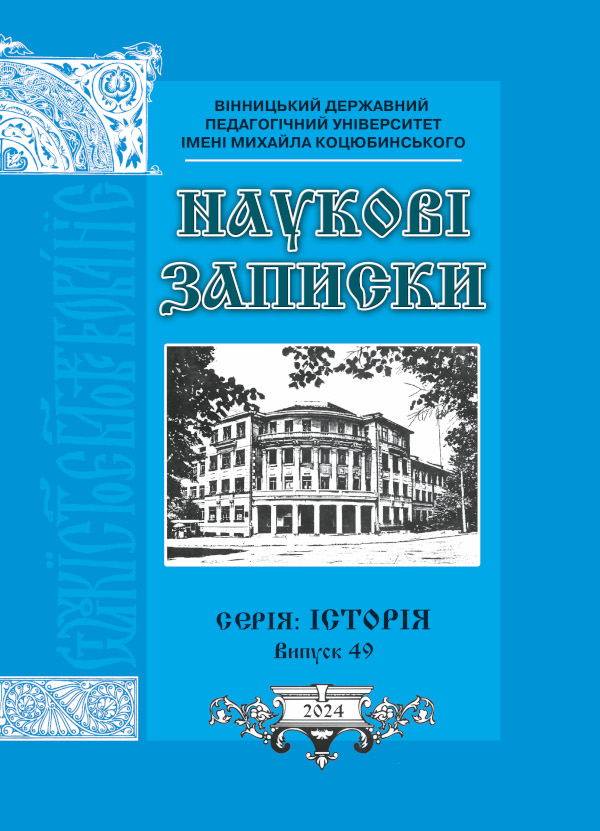Abstract
The purpose of the article is to reconstruct the life and activities of a Japanese diplomat, primarily in the field of rescuing Jews in the first years of World War II (1940–1941). The author characterizes Sugihara's personal qualities, working conditions in various parts of Europe, particularly in Lithuania and East Prussia, and examines the forms and methods of rescuing Jews. The research methodology is based on a combination of general scientific (chronological, problem-historical, analytical, synthesis, generalization) and special-historical (historical-typological, historical-systemic) methods with the principles of historicism, objectivity, systematicity, scientificity, verification, using interdisciplinary approaches to the intersection of world history, psychology, ethics; memories of contemporaries of the World War ІІ. The scientific novelty of the work lies in the fact that, using these methods, the author reveals the character of Sugihara as the savior of European Jewry, analyzes the number of visas issued and the impact of his diplomatic activities on the future fate of Jewish refugees – applicants for temporary asylum in Japan. Conclusions. The Japanese savior, with all his diplomatic activities and «righteous» life, demonstrated an absolute immersion in the Jewish problems of the World War ІІ. Despite all the obstacles that stood in his way, he was able to save thousands of refugees who asked for transit visas to Japan in order to find a peaceful life in other countries of the world. In Lithuania, Sugihara could not calmly look at the constant crowds at the windows of his residence, mainly Polish Jewish refugees who found refuge in Lithuania after the Nazi occupation of Poland, but with the Soviet occupation of the country had to continue to arrange their lives in other countries of the world. In East Prussia, the consul faced a similar problem. Being familiar with the Nazi policy of anti-Semitism in the occupied and annexed territories of the Reich, Sugihara understood well what future awaited Jewish asylum seekers, and could not refuse them help. The diplomat, despite the fact that he belonged to a country that became an ally of Germany in the World War ІІ and had its own colonial ambitions in Southeast Asia, did not fall victim to anti-Semitic propaganda and Judeophobia, but on the contrary showed sympathy for asylum seekers. Today, there are 40,000 to 50,000 descendants of those Jews who were helped by the Japanese diplomat living in the world.
References
Gold, A. (2014). A Special Fate: Chiune Sugihara: Hero of the Holocaust. TMI Publishing.
Levine, H. (2012). In Search of Sugihara: The Elusive Japanese Diplomat Who Risked His Life to Rescue 10,000 Jews From the Holocaust. New York.
List of people who received a visa from Sugihara. https://www.yadvashem.org/yv/en/righteous-linked/stories/pdf/sugihara_list.pdf
Medzini, M. (2016). Under the Shadow of the Rising Sun: Japan and the Jews During the Holocaust Era. Boston.
Nakar, E. (2008). Sugihara Chiune and the Visas to Save Lives: Assessing the Efforts to Memorialize a Japanese Hero. Asia-Pacific Journal-Japan Focus, 6(1), 1-17
Palasz-Rutkowska, E. (1997). Raport konsula Sugihary Chiune. Japonica, 7, 129-139
Sakamoto, P. (1998). Japanese Diplomats and Jewish Refugees: A World War II Dilemma. Praeger.
Shiraishi, M. & Sekimori, G. (2021). Sugihara Chiune: The Duty and Humanity of an Intelligence Officer. Tokyo.
Sugihara Chiune and the Soviet Union: New Documents, New Perspectives. David Wolwff, Takao Chizuko and Ilya Altman (eds). [Чиунэ Сугихара и Советский Союз: новые документы, новые перспективы / Сост.: Илья Альтман, Чизуко Такао, Дэвид Вольф]. Sapporo-Tokyo-Moscow, 2022. 230 s.
Sugihara House. https://www.sugiharahouse.com/#/en
Sugihara, S. & Hu, N. (2001). Chiune Sugihara and Japan's Foreign Ministry: Between Incompetence and Culpability. Part II. University Press of America.
Sugihara, Yu. (1995). Visas For Life. Edu-Comm Plus.
Venclauskas, L. (2009). Chiune Sugihara: Visas for Life. Versus Aureus.
Wolff, D. (2014). Chiune Sugihara and the Great Eurasian Neutrality of 1939−1945. В отблеске «Хрустальной ночи»: еврейская община Кёнигсберга, преследование и спасение евреев Европы: Материалы 8-й Международной конференции «Уроки Холокоста и современная Россия»; под ред. И. Альтмана, Ю. Царуски, К. Фефермана. Москва-Калининград, 187-196
Альтман, И. (2014). Праведник народов мира Чиунэ Сугихара. Новая и Новейшая история, 5, 184-203
Альтман, И. (2014а). Чиунэ Сугихара и разрешение СССР на транзит в Японию еврейских беженцев. В отблеске «Хрустальной ночи»: еврейская община Кёнигсберга, преследование и спасение евреев Европы: Материалы 8-й Международной конференции «Уроки Холокоста и современная Россия»; под ред. И. Альтмана, Ю. Царуски, К. Фефермана. Москва - Калининград, 197-205
Антоненко, В. (2022). Хронология жизни и деятельности Чиунэ Сугихары и транзита беженцев (1900-1947 гг.). https://src-h.slav.hokudai.ac.jp/coe21/publish/no35_ses/12.pdf
Беженцы в Литве. Историческая справка. https://www.yadvashem.org/ru/righteous/stories/refugees-in-lithuania.html
Брускина, Т. (2014). НКВД и изготовление фальшивых японских виз в 1940-1941 гг. в Литве. В отблеске «Хрустальной ночи»: еврейская община Кёнигсберга, преследование и спасение евреев Европы: Материалы 8-й Международной конференции «Уроки Холокоста и современная Россия»; под ред. И. Альтмана, Ю. Царуски, К. Фефермана. Москва-Калининград, 225-231
В Литве вспоминают спасителя 6000 евреев Чиюне Сугихару. https://www.lrt.lt/ru/novosti/17/1239409/v-litve-vspominaiut-spasitelia-6000-evreev-chiiune-sugikharu
Воробьева, Е. (2023). Личность Сигухара Тиунэ (1900-1986) и сохранение исторической памяти о нем. Ежегодник. Япония, 52, 409-441. https://doi.org/10.55105/2687-1440-2023-52-409-441
Личная история. Лео Меламед. Режим доступу: https://encyclopedia.ushmm.org/content/ru/oral-history/leo-melamed-describes-life-as-a-refugee; https://encyclopedia.ushmm.org/content/ru/oral-history/leo-melamed-describes-train-ride-across-the-soviet-union
Личная история. Рут Беркович Сегал. Режим доступу. https://encyclopedia.ushmm.org/content/ru/oral-history/ruth-berkowicz-segal-describes-journey-to-and-arrival-in-japan; https://encyclopedia.ushmm.org/content/ru/oral-history/ruth-berkowicz-segal-describes-receiving-visa-to-leave-lithuania
Президент зустрівся з сином Чіуне Сугіхара. Режим доступу: https://madeinvilnius.lt/naujienos/lietuvos-naujienos/prezidentas-susitiko-su-ciunes-sugiharos-sunumi/#google_vignette
Семпо Сугихара объясняет свои действия. https://www.yadvashem.org/ru/righteous/stories/sugihara/sugihara-explanation.html
Сираиси, М. (2007). Японский дипломат Сугихара Тиунэ, который спас 6000 евреев. Заметки по еврейской истории, традиции, культуре, 18. https://berkovich-zametki.com/2007/Zametki/Nomer18/Zinberg1.htm
Феферман, К. (2014). Отношение к спасению посредством виз в еврейских религиозных кругах в Литве, 1940-1941 гг. В отблеске «Хрустальной ночи»: еврейская община Кёнигсберга, преследование и спасение евреев Европы: Материалы 8-й Международной конференции «Уроки Холокоста и современная Россия»; под ред. И. Альтмана, Ю. Царуски, К. Фефермана. Москва - Калининград, 216-224
Чиуне Семпо Сугихара (Япония). https://www.yadvashem.org/ru/righteous/stories/sugihara.html
Японский дипломат Сабуро Ней – спаситель евреев. Документальные доказательства. http://remembrance.ru/2020/06/30/pravednik

This work is licensed under a Creative Commons Attribution 4.0 International License.
Copyright (c) 2024 Maryna Mykhailiuk





